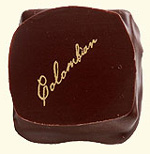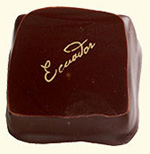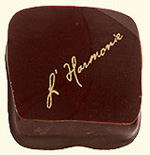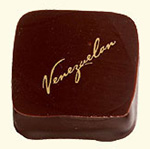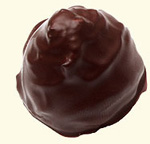
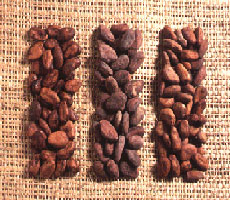 Criollo, Forastero and Trinitario beans. Photo courtesy of Chocovic. Read our review of Chocovic.
Criollo, Forastero and Trinitario beans. Photo courtesy of Chocovic. Read our review of Chocovic.
April 2005
Updated July 2009
|
 |
The Flavors & Aromas Of Varietal Chocolate
Page 4: Single Origin Chocolate Regions
by Peter Rot & Karen Hochman
THE NIBBLE Guide To The World’s Great Cacao Beans
& The Varying Flavors of Single Origin Chocolate
Location, location, location. Just as with wine grapes or coffee, take the same cacao bean—Criollo, Forastero or Trinitario—plant it in a different region, and the result will taste very different.
This material is copyrighted. Reprints, redistribution and repurposing are by written
permission only.
COUNTRY |
FLAVOR PROFILE |
GROWING REGIONS AND THEIR CHARACTERISTICS |
| AFRICA |
|
|
| Cote d’Ivoire |
•Forastero
•Bold, hearty
•Noncomplex blending beans
•Cocoa, tobacco, and leather |
Bold and hearty cacao, Ivory Coast has long been a favorite supplier of bulk beans. It’s an excellent choice for blended chocolate because of its boldness and noncomplex flavor of cocoa, tobacco, and leather. |
| Ghana |
•Forastero (mostly)
•Bold, assertive, full-bodied
•Not bitter
•Chocolate, coffee, tobacco
|
Ghana cacao is bold, assertive, and full-bodied. Most of it is Forastero, but the bitterness level of the beans is relatively low, so it’s much more soothing and gentle on the palate. Also, it’s strongly chocolaty. This makes it perfect for blending, especially since common flavors are coffee and tobacco. |
| São Tomé |
•Forastero (Amelonado)
•Red fruits
•Cinnamon, vanilla
•Tart, forward
•Smoky
|
São Tomé is an island republic in the Gulf of Guinea. The cacao grown is predominantly Forastero, the progeny of Amelonado cacao brought to the island in the 1820s. São Tomé cacao can be bitter, sharp and smoky, and its range of flavors includes pure cacao (chocolaty), sharp red fruits, cinnamon and vanilla. It can be tart and aggressive, full-forward on the senses, and offers little in the way of delicacy. While it makes good single origin chocolates, it also is a good base for blended chocolate. |
| CARIBBEAN |
|
|
| Grenada |
•Trinitario
•Light body
•Fresh dairy, white fruit
•Woody & grassy
•Acidic, citrus |
Home to some fine Trinitarios, Grenada’s cacao shares similar flavor properties with many of its Caribbean cousins. It is lighter on the palate with varying flavors of fresh dairy, woody and grassy nuances, white fruitiness, and even some degree of acidity, depending, on the manufacturer. |
| Haiti |
•Trinitario
•Light body
•Noncomplex
•Strong acidity
•Sweet spice, cocoa |
Somewhat light in body, this cacao has a relatively strong acidity level. Rather noncomplex flavor of sweet spice and cocoa. Good in blends but not the most impressive cacao on its own. |
| Jamaica |
•Trinitario
•Light to medium body
•Rum, fresh dairy
•Peaches, cedar, juniper
|
Cacao grown here is predominantly of the Trinitario type and is often light-to-medium on the palate with a unique Caribbean gentleness. Flavors of sweet rum and fresh dairy are common, along with peaches and even woody notes of cedar and juniper.
|
| Trinidad |
•Trinitario
•Light tone, delicate character
•Woody and spicy
•Chocolate, grass, butter
•Citrus & tropical fruits
|
Trinidad has about 21 distinct growing regions, but the most well-known is Gran Couva, the plantation popularized by Valrhona. Trinidad is regarded as the birthplace of Trinitario cacao, the hybrid of Criollo and Forastero that was created in the 1700s, after the island’s Criollo crop was largely wiped out by forces of nature. Forasteros were introduced to restore the island’s cacao crop but a unique hybridization with the few remaining Criollos resulted in the entirely new Trinitario species, with the delicate flavor of Criollo and the hardiness of Forastero. Trinidadian cacao can vary tremendously in flavor, so one might taste woodiness and spicy tartness in one chocolate, grass and butter tones in another, and slight citrus and tropical nuances in another—or perhaps a combination of all flavors in one chocolate. Generally, the body is medium and somewhat delicate in overall character and pleasingly chocolaty. |
| SOUTH AMERICA |
|
|
| Brazil |
•Forastero
•Bold, assertive
•Noncomplex
•Vanilla, cocoa, woody |
Brazil produces mostly Forastero cacao, with a bold and often noncomplex flavor profile. Used mainly as bulk beans, the flavor is monotone and assertive with common flavors of vanilla, cocoa, and accompanying woody nuances. Popular in blends for the chocolatiness it provides but not a good selection for single origin bars. |
| Ecuador, Colombia |
•Forastero (unusual type)
•Light palate, heavy body
•No Forastero bitterness
•Not bitter
•Coffee, nuts, vanilla, and spice |
Nacional or Arriba. Predominantly grown in Ecuador and Colombia, some consider Nacional (also called Arriba) a Forastero, while others argue that it’s a fourth subgroup of cacao altogether. Either way, Nacional is still regarded as a flavor cacao like Criollo (which imparts flavor nuances). The flavor is typically subtle and light on the palate, but the body is heavy and bold. Generally, it possesses a lovely chocolaty flavor with light floral and fruity notes, along with coffee, nuts, vanilla, and spice. The bitterness level of these beans is practically nonexistent, which further adds to the uniqueness of its character. Nacional is unlike typical Forastero because it lacks the bitterness and instead possesses a much more subtle flavor like its Criollo cousins. The result is a cacao that shares the same hearty flavor of Forastero and subtlety of Criollo. Nacional could be viewed as the best of both worlds. Although delicious by itself, it makes an outstanding choice for blended chocolate, because it provides body and a deep chocolaty richness, and also lends its own delicate flavor. |
| Venezuela |
|
Venezuela has two distinct growing regions: Sur del Lago and the Andean. Many different subspecies of cacao are grown in both regions. The cacaos are further distinguished by names typically derived from shipping ports or villages where the cacao was grown. For example, Rio Caribe cacao is grown near Rio Caribe; and Carenero Superior refers to the Carenero port, which was once a high-traffic port for this type of cacao (“Superior” denotes the finer quality of the beans). The quality cacaos of Venezuela are:
|
| |
•Trinitario (mostly)
•Caramel, citrus, vanilla, berries, honey
•Chocolate undertone
•Light acidity |
Carenero Superior. Mostly Trinitario. Carenero refers to the port from which the cacao was once shipped, and “Superior” is a reference to higher quality beans. Typically, Carenero has a strong underlying chocolaty presence that hides underneath a myriad of flavors, such as spice, caramel, citrus, vanilla, berries, and honey. A light acidity also adds further depth to the profile. |
| |
•Criollo & Trinitario
•Intense, assertive
•Blueberries, plums
•Molasses, vanilla
•Sharp acidity
|
Chuao. A village in Aragua State; Criollo and Trinitario blend (even some Forastero). Intense flavor with notes of blueberries, plums, molasses, and traces of vanilla. This is an assertive and powerful cacao with a sharp acidity; one of the rarest, most and most complex cacaos.
|
| |
•Criollo & Trinitario
•Dairy, woody
•Red fruits, peach
•Sharp, acidic |
Cuyagua. A village in Aragua State; a blend of Criollo and Trinitario. Interesting flavors of dairy, sharp red fruits, slight woodiness, and even some peach. Quite sharp and acidic cacao. |
| |
•Criollo
•Full-bodied
•Average complexity
•Red fruits, cream, spice, nuts |
Maracaibo. From the Sur del Lago region, this Criollo cacao is grown near the banks of the Maracaibo River. This cacao is inherently hearty with a full body. Its complexity is fairly minimal and can display wonderful flavors of red fruits, cream, spice and nuts.
|
| |
•Criollo & Trinitario
•Sharp
•Spicy, peaches, red fruits
•Dairy |
Ocumare 61. Originally from the Ocumare de la Costa valley; Criollo and Trinitario hybridized blend. This cacao is gentle and light, but it still possesses a slight acidic punch. Flavors can vary, but most often, it yields earthy spiciness, peaches, red fruits and fresh dairy. |
| |
•Criollo & Trinitario
•Darker, robust
•Cashews, peanuts
•Spice, pepper
|
Ocumare 67. Originally from the Ocumare de la Costa valley, a Criollo and Trinitario hybridized blend. Interesting flavors of cashews, peanuts, spice, pepper, and sometimes dairy. The tone is a little darker than Ocumare 61 and it does not possess 61’s sharpness. It is more robust than 61 in overall character, with a heavier body. |
| |
•Criollo
•Mild & delicate
•Great finesse
•Strawberries, cream
•Butter, bread |
Porcelana. From the Andean region, a genetically pure Criollo species. This cacao is extremely mild, and is prized for its delicacy and overall gentle appeal. While not a complex cacao, the flavors and texture are incredible and dazzle with finesse. Typical flavors are strawberries, cream, butter, and sometimes bread. Mexican strands of Porcelana deviate from the Venezuelan variety with a heavier body and spicier flavor profile. |
| |
•Criollo
•Dark tone, bitter
•Coffee, cocoa
•Almonds, red fruits |
Rio Caribe. From Sucre State, a Trinitario grown near the Rio Caribe. This cacao has a slight dark tone and a refreshing bitterness. Flavors common among this cacao are coffee, almonds, slight red fruits, and pure cocoa. |
| |
•Criollo & Trinitario
•Hearty & robust
•Butter, hazelnuts
•Red fruits, floral |
Sur del Lago Clasificado. A mix of Criollo and Trinitario beans. Typically, this cacao is hearty, robust and full-bodied with flavors of butter, hazelnuts, and red fruits. There are floral tones, and the cacao can have a brief bitter peak at the finish.
|
SOUTH PACIFIC |
|
|
| Java |
•Criollo
•Light body, bold flavors
•Acidic, citrus
•Leather & smoke
|
Javanese beans often are used in milk chocolate because they usually offer bold flavors that can withstand the dilution of the milk solids and the relatively low cocoa content. The cacao is highly acidic and citrus-like in its flavor presentation, but bolder flavors of leather and smoke are also very common. Overall, the cacao is extremely light in body but strong in flavor. |
| Madagascar |
•Criollo
•Citrus acidity
•Grape/pineapple
•Vodka/white wine
•Lighter, not bitter
•Sometimes cedar, woody, spice |
Madagascan cacao is often vibrant with a crisp citrus acidity, but grape, pineapple, and even cranberry notes are common as well. Alcohol notes, interpreted as as vodka and white wine, sometimes accompany these flavors. Spice, cedar, and other woody notes are appearing in more Madagascan chocolate nowadays, thus providing a larger myriad of flavors. Overall, the cacao is light on the palate and contains no bitterness. |
| |
|
|
Master the bean and regional characteristics on this page, and you’ll be able to hold your own with experts at blind tastings—and at the very least, more deeply analyze, appreciate and enjoy each delicious piece of fine chocolate that passes your way.
See our glossary of chocolate terms.
|
Varietal Chocolate Bonbons
In addition to the designated origin chocolate bars made by most fine chocolate houses, a number of individual chocolatiers include one or more varietal bonbons in their assortments. San Francisco chocolatier Michael Recchiuti, for example, makes five “varietals.” The palets are filled with ganache and the bonbon is described below. Most people would agree that it is easier to taste the varietal differences in a pure chocolate bar, before the flavors have been diluted with cream in a ganache. However, if you have a good palate, you’ll appreciate the single origin experience in bonbon form as well.
- The Columbian palet is made of cacao from the Chucurreno region, showing berry and spice notes and a long finish.
- The Ecuador, the most dramatic of the four palets, is made from a single cacao bean varietal, has smokey tobacco notes, a hint of earthiness, and a rich, coffee color.
- L’Harmonie is a blend of cacao from the Caribbean, Central and South America. The blend provides an elegant complexity. Nutty and floral tones are enhanced by the addition of Tahitian vanilla bean.
- The Venezuela is made with cacao from the Sur del Lago region. Less complex than the other varietals, it exhibits delicate nut and caramel tones.
- The Sur del Lago bonbon has extra-bitter chocolate ganache atop a pure Sur del Lago chocolate disk, topped with crushed Sur del Lago cacao nibs; then enrobed in pure bittersweet chocolate.
|
You can have a chocolate tasting with friends to study the different regional characteristics and add to your understanding of the cacao bean and its terroir. Read our pointers on how to conduct a chocolate tasting.
Go To The Article Index Above

|



